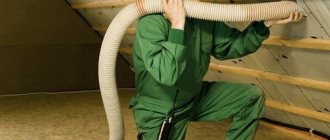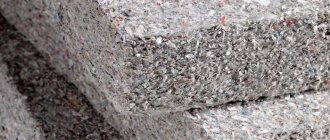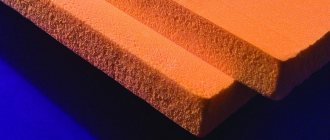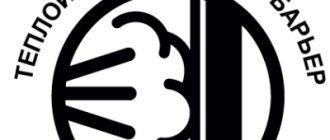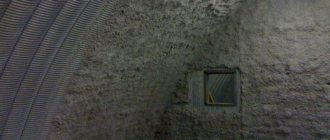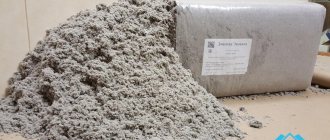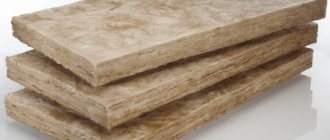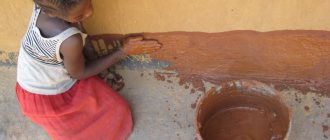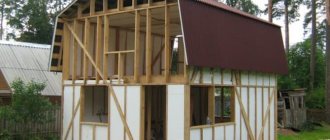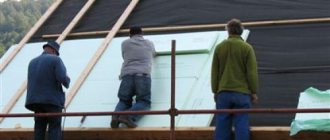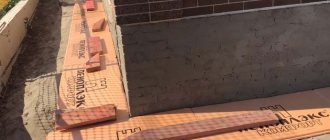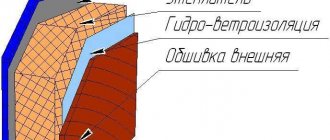If you are planning to build a house for yourself and are choosing insulation, then this article is especially for you. In this article we will introduce you to the insulation material - Ecowool.
In the photo there is a 15kg Ecowool briquette (Donskaya Ecowool, Tula)
In the photo there is a 15kg Ecowool briquette (Donskaya Ecowool, Tula)
Table of contents:
- A little history
- Ecowool composition
- What is Borax
- Boric acid
- Ecowool insulation cost
- Thermal conductivity Ecowool
- Air permeability Ecowool
- Energy efficiency Ecowool
- Capillary activity of Ecowool
- Fire safety Ecowool
- Environmental friendliness Ecowool
- Rodents and mice in Ecowool
- Ecowool - antiseptic
- Noise insulation Ecowool
- Heat capacity of ecowool
- Ecowool shrinkage
The history of ecowool
Ecowool is the Russian name for cellulose insulation. In world practice it is called “Cellulose Insulation”. Ecowool appeared in Russia in 1993, but in world practice it became known already at the beginning of the last century. In 1928, the first production of this insulation was created in Germany. Today, this insulation is well known and popular in many countries around the world. This insulation is especially popular in countries located in northern latitudes, in the humid climate zone:
- Finland
- Sweden
- Norway
- Germany
- Canada
- USA and other countries
According to the Russian information portal Wikipedia, in Finland, cellulose insulation accounts for up to 70% of the total market for insulation used in individual housing construction.
What does this insulation consist of?
Ecowool 81 % recycled cellulose (newsprint paper), 7 % of Borax anti-friction agents (flame protection) and 12 % of natural antiseptics Boric acid (protection from rodents, mold, insects)
Ecowool composition
This is what ecowool looks like up close, it is a fibrous crushed material, gray in color, some inclusions may be present in the form of scraps of newspaper waste paper, sometimes you can even make out the text.
Fiber structure Ecowool
It has no smell and does not generate dust. Ecowool can be compressed, it takes a fixed shape, this can be used, for example, when installing this insulation into small cracks yourself. In addition, there is no need to fear that it will fall out of the holes through which it was mounted. It holds its shape and will not fall out anywhere.
What kind of material is this?
Ecowool is a loose thermal insulating material, gray in color and made on the basis of cellulose. The material includes:
- recycled paper (about 81 percent);
- fire inhibitors (about 7 percent), which form a self-extinguishing effect and increase the fire resistance of ecowool to 232 degrees;
- fungicides and antiseptic substances (about 12 percent), protecting the material from the effects of fungi, mold, mice, etc.
It is also worth noting that the manufacturing procedure for this insulating material takes only five minutes. First, waste paper is delivered to the production site. It is poured onto a special conveyor, through which the paper enters the so-called primary mixer. There, the material is divided and cleared of metal elements (such as paper clips) using a built-in magnet. Next, the raw material is crushed using the same mixer into small shreds (width - about 50 millimeters), fire retardants and antiseptics are added.
Then the raw material is fed into another device - a fiber manufacturer, which crushes it into thinner pieces (dimensions are about 0.4 centimeters). A small amount of borax is added at the end. That's it, the cellulose insulation material is ready for use!
Same composition in all countries
I would like to especially draw your attention to the fact that despite the wide geography of application of this insulation, in almost all countries, including Russia, the manufacturing technology of this material, its composition, are almost the same - it includes three components: this is cellulose - newspaper waste paper, this is borax and boric acid .
If everything about waste paper is very clear, then about borax and boric acid, not so much. Let's look at them in more detail:
So, what is Borax?
Sodium tetraborate (“borax”, “borax” (from Latin borax
)) is an inorganic compound, sodium salt of boric acid with the chemical formula Na2B4O7, the most common and used boron compound, forms several crystalline hydrates, and is widely used in industry.
In the photo "Bura"
Sodium tetraborate (Borax) is used:
- as a raw material for the production of boric acid and various boron compounds
- in the production of enamels, glazes, optical and colored glasses, various ceramics
- when soldering and melting metals in flux
- in the paper and pharmaceutical industries
- in the production of building materials as an antiseptic component for the production of cellulose insulation ecowool
- as a disinfectant and preservative
- for preparing buffer solutions
- in analytical chemistry (as a standard substance for determining the concentration of acid solutions)
- for qualitative determination of metal oxides (by pearl color)
- in photography - in slow-acting developers as a weak accelerating agent
- as a component of detergents
- as a component of cosmetics
How to make ecowool with your own hands, equipment and blowing of ecowool
Ecowool is one of the types of thermal insulation materials. This is a cellulose insulation that consists of an antiseptic and recycled cellulose. Cellulose fibers make up almost 80% of the material itself. It creates an excellent homogeneous seamless layer of insulation. What is ecowool insulation, reviews about it - we will talk about this in our article.
Definition of ecowool. Its advantages
Ecowool consists of fibers that contain lignin, a substance that, when moistened, imparts stickiness. This material is completely harmless and absolutely non-toxic.
In addition, all its components are non-volatile, which means that they cannot harm the environment and people.
There are other advantages:
- good thermal insulation and sound insulation material;
- not susceptible to rotting and fungus;
- in the event of a fire, it is not susceptible to fire for a long time;
- trouble-free installation;
It should be noted that in ecowool, as in all thermal insulation materials, rodents appear that consider it as their food.
This material contains substances such as boric acid and borax. They reduce the fire hazard and provide good protection against fungi and rot. The low cost of wool is associated with simple installation and inexpensive raw materials from which it is made.
Do-it-yourself ecowool. Laying methods
Ecowool can be installed by both professionals and amateurs. There are the following installation methods:
Blowing ecowool with your own hands confronts a person with certain problems. This method is used to insulate floors and flows. Ecowool is easy to install with your own hands; no special equipment or special skills are required.
Manual installation includes several stages.
First you need to prepare the insulation by pouring it into a container such as a bucket or basin. The next stage, “fluffing,” is carried out using a drill.
Blowing ecowool with your own hands requires direct manual installation, which consists of filling it into the ceilings. But there are situations in which additional blow molding equipment is required. After filling the insulation, it must be closed. To do this, you can use sheet materials, for example, plywood.
With the mechanized laying method, equipment specially designed for this is used. And wet-glue processing is usually carried out by professionals.
It is the last method that is of the highest quality.
Having considered what ecowool is with your own hands, the equipment that is used in this process is also worth considering:
- blowing installation - necessary for uniform supply of insulation;
- corrugated hoses - supply ecowool to the place of insulation;
- pump set;
- special nozzles for blowing.
This equipment is necessary when it comes to mechanized insulation of a building.
Recommendations for do-it-yourself insulation
Using ecowool, you can insulate your walls yourself. floors, ceilings, attics and roofs. On construction sites you can find out more specifically what ecowool insulation is, reviews about this process and recommendations.
But we will give some basic recommendations in our article:
To determine the density, it is necessary to take into account the material consumption
It is important to know that when insulating with your own hands, the material consumption is much higher than with mechanized insulation. Density control can be calculated using a formula and thereby reduce material consumption. To insulate different floors, there are standards for the thickness of the floor. The thickness of the ceiling for the floor is 15-20 cm, for attic floors - up to 30 cm, the thickness of the ceilings between floors is 15-20 cm. If the ecowool insulation process is carried out manually, then it must be taken into account that the material consumption may be slightly higher than originally envisaged. When insulating materials such as concrete, brick or iron with ecowool, it is necessary to prevent the possibility of the ecowool absorbing condensed moisture. Likewise, when insulating a roof, it is imperative to protect the insulation from penetration of sub-roof condensate. This can affect not only the quality of the building's thermal insulation, but can lead to gradual destruction. This thermal insulation material is excellent for insulating residential buildings and utility rooms, as well as for insulating individual building elements.
This can affect not only the quality of the building's thermal insulation, but can lead to gradual destruction. This thermal insulation material is excellent for insulating residential buildings and utility rooms, as well as for insulating individual building elements.
Boric acid
Boric acid (orthoboric acid or lat. acidum Boricum) is a weak, monobasic Lewis acid, often used as an insecticide, antiseptic, and fire retardant.
In the photo "Boric acid"
Application
- Boron fertilizer
- Used in laboratories to prepare buffer solutions
- In medicine - as an independent disinfectant for adults, and also in the form of a 2% solution - for washing the skin after contact with alkalis
- Also, various combination preparations are produced based on boric acid (ATX group D08AD), for example Teymurov’s paste
- Registered in the food industry as food additive E284
- In jewelry - as the basis of fluxes for soldering gold-containing alloys
- In everyday life - extermination of cockroaches, ants, bedbugs
- In the production of ceramics, fiber optics, fiberglass, glass
- As a fire retardant to protect wood
- As part of electrolytes for copper and nickel plating
Cost of insulation - Ecowool
For correct calculation, let's take the insulation thickness of 100 mm. The price will include all work and the material itself.
Horizontal surface - 190 R/m2
Sloping and vertical surfaces from 240 R to 350 R/m2
The approximate cost of insulating a house with a total area of 120-150 m2 on a turnkey basis (thermal circuit) ranges from 100 to 200 thousand rubles. The price is comparable to all types of insulation with basalt or mineral slabs.
Insulation calculator
Ecowool calculation calculator
Thermal conductivity Ecowool
Thermal conductivity is the ability of material bodies to conduct energy (heat) from more heated parts of the body to less heated parts of the body through the chaotic movement of body particles (atoms, molecules, electrons, etc.).
The thermal conductivity coefficient of ecowool is 0.039 (W/m*K)
For understanding, below are data on the most common types of insulation.
Thermal conductivity table
The table shows that the thermal conductivity coefficient of ecowool is higher than the average result.
PPU
Polyurethane foams are based on polyester with the addition of emulsifiers, disocyanate and water. Under the influence of catalysts, the chemical reaction of the starting components produces a new substance called polyurethane foam (PUF). The advantages of polyurethane foam include high noise absorption, chemical passivity, and moisture resistance.
PPU refers to thermal insulation that is sprayed onto the surface: this way it covers even complex and hard-to-reach areas of ceilings and walls. The density of polyurethane foam reaches 80 kg/m3, the thermal conductivity coefficient is one of the lowest among various TIMs - 0.028 W*m/K.
Fibrolite
Wood wool refers to small, narrow pieces of wood shavings. It is wood wool that is the basis for fiberboard.
This insulator is produced in the form of slabs and is not afraid of exposure to the external environment.
The density of this material ranges from 300 to 500 kg/m3, and thermal conductivity reaches a value of 0.1 W/m per Kelvin.
Ecowool
Cellulose insulation or ecowool is a natural material that contains waste from paper and cardboard production and waste paper. Available in large bags filled with paper waste. The undoubted advantages of ecowool include its good thermal insulation properties and the ability to absorb various noises.
There are several ways to install this thermal insulator, the most effective of which is spraying. What are the operational difficulties? The disadvantages of cellulose insulation include a decrease in its qualities over time. After several years of operation, ecowool loses 20% of its volume, thereby worsening the thermal insulation of the home.
Air permeability of ecowool
Thanks to the technology of seamless application and the dense fibrous structure of the material, ecowool has low air permeability. The absence of joints and cracks determines the future tightness of the entire building.
A house insulated with cellulose fiber is 40% more energy efficient
There is a video on the Internet devoted to a comparative analysis of this “tightness” parameter. In America, they took two houses, identical in design, one house was insulated with mineral wool, the second house was insulated with cellulose insulation. And when we compared the tightness of the thermal insulation circuit of these 2 buildings, we were surprised to find that the tightness of a house insulated with cellulose insulation was 40 percent higher than the figure for a house insulated with traditional fiberglass. Here is the link to this video.
High capillary activity of ecowool
Ecowool has high capillary activity
What it is? What does this give?
There are 2 mechanisms of moisture transfer inside the insulation:
- Capillary
- Diffusion
Thanks to wood fiber, ecowool uses both of these mechanisms; mineral types of insulation have only one - diffusion . Ecowool mainly consists of cellulosic wood fiber. When moistened, the fiber is able to absorb moisture and distribute it throughout the entire volume of the insulation. Due to the different molecular structure, basalt insulation cannot distribute moisture.
The photo shows the structure of the molecules of ecowool and mineral wool
This is a rather complex phenomenon and it gives rise to great controversy regarding the use of vapor barrier when insulating with ecowool. Proponents of the idea that a vapor barrier is not needed precisely mean this additional mechanism of moisture transfer, which works in the opposite direction and ecowool has the ability to dry not only outside, but also inside.
Capillary activity provides a number of advantages to ecowool,
compared to insulation materials that do not have
capillary activity.
What is ecowool
Remembering that suburban construction in Russia began to actively develop in recent times, ecowool appeared relatively recently in St. Petersburg and the Leningrad region.
Acquaintance with Ecowool in low-rise suburban construction in St. Petersburg began in unfavorable conditions for it: it was unclear about the supply of cellulose insulation, not to mention the equipment for installing Ecowool, although it was used in Europe even in pre-war times. But even in our time, we still hear from construction teams who have built more than one country house: ECO-WOOL - what is it? Ecowool is an environmentally friendly material that consists entirely of natural ingredients:
- borax – 7%;
- boric acid – 12%;
- recycled cellulose – 81%.
The loose consistency of ecowool allows for seamless installation, after which there will be no drafts, mice or insects in the house. There is no problem with residues - there is no waste during installation, every gram of ecowool will reliably protect your home.
Pros of high capillary activity
- When moistened, the insulating properties of the insulation are preserved.
- Due to the redistribution of moisture through the capillaries, there are no zones of local waterlogging.
This is important when there is some kind of defect in the vapor barrier.
3. Condensation does not form in Ecowool.
4. Ecowool, due to the capillary mechanism, can affect the humidity of the room air. It absorbs excess moisture and releases it when the room becomes dry, that is, like wood fiber, it is a passive regulator of air humidity in the room.
If you do not plan to install supply and exhaust ventilation, then this property will significantly add comfort to your home.
Eco-friendliness of ecowool
There is a lot of controversy about the environmental friendliness of ecowool. There are extreme supporters that it is very environmentally friendly. Others say that it is not at all environmentally friendly, let's try to figure it out.
Ecowool consists of three components:
- Newspaper waste paper
- Borax
- Boric acid
“Ecowool is full of lead because it’s made from newsprint.”
As for newspaper waste paper, it means there is no lead in the newspaper since it has long been produced in a way that eliminates the presence of lead in the equipment.
“Printing ink is harmful to health”
The harm caused by printing ink is greatly exaggerated; it has its own hygienic certificate, on the basis of which newspapers are produced. Millions of people read, touch, enclose every day and no one has yet gotten sick, much less died, from contact with printing ink. So we can say with confidence - “This is a myth”
Technical and operational characteristics
So, all we have to do is talk briefly about the operational parameters, because of which, in fact, many people prefer this material. We should start with primitive mathematics: for example, we use a slab or roll type heat insulator, after installation of which there are joint gaps of 4 percent.
And this, obviously, is no longer effective work, since thermal conductivity is reduced by at least half. But if you look from the other side, ecowool fills the voids under the finishing material as evenly as possible, and all joints and voids are closed.
The application technology in most cases involves spraying, as demonstrated in the image. But, in principle, you can simply lay it down.
It is also necessary to take into account noise insulation parameters, which are enhanced due to the penetration of thin cellulose fibers into almost all crevices. For example, if you install 5 centimeters thick insulation on 12.5 mm drywall, the noise level will drop to at least 63 decibels. If you increase the thickness further, then with each centimeter the sound insulation will increase by another 4 decibels.
Now let's get acquainted with other technical parameters that cellulose insulation has.
The density of ecowool averages 30-65 kilograms per cubic meter, although more precise figures depend on the specific manufacturer and scope of application of the insulation.
Thanks to its frost resistance class, the material can last up to 80 years.
We talked about thermal conductivity, it is quite high. However, it may change in one direction or another depending on the application technology used.
As for vapor permeability, it is 0.3 mg/(m*h*Pa) for ecowool.
Finally, the flammability class of most insulation is B1 (hard-to-flammable material) or G2 (that is, moderately flammable). Sometimes D2 is also found, which, according to GOST, denotes materials characterized by low smoke-generating ability.
GOST 30244-94. Flammability of building materials. File for download.
GOST 30244-94
Video - Checking cellulose insulation
Disadvantages of the material
Yes, ecowool has disadvantages and you should definitely familiarize yourself with them.
- First of all, if spraying is carried out using a wet method, then all iron elements of the structure must be protected with special paint or varnish, otherwise they will begin to rust. The fact is that such insulation dries completely only after two months.
- Price. For example, walls need a density of at least 60 kilograms per cubic meter. A cubic meter of ecowool consists of four packages of 15 kilograms each. It turns out that the cost of insulation starts from 1,600 rubles. If you compare it with mineral wool (it costs from 1,300 rubles), then it is actually quite expensive. For manual installation on flat surfaces, the cost is slightly lower - about 900 rubles. per cubic meter, provided that the density of the material is 35 kilograms per cubic meter.
- There are no specific requirements regarding cellulose insulation in either GOST or SNiP, so the quality of the material depends only on the honesty of the manufacturer. And numerous reviews from dissatisfied customers are clear confirmation of this.
- Ecowool is not used under cement screed. This material is soft, therefore, it needs free space.
- Finally, the last minus is significant shrinkage. Some time after installation, it weathers through cracks and gaps, so careful sealing of all defects in the finished coating is a prerequisite.
As you can see, all the shortcomings are very important, but their number and presence, in principle, depend on which specific company was engaged in production. Some people use ammonium sulfates instead of boric acid, which is why biological stability is noticeably reduced. Before purchasing material, be sure to ask the seller for all necessary certificates. In addition, check how much the package weighs, compare the resulting weight with the weight of other similar products.
Note! If there are no certificates and markings on the packaging, and if the insulation is sold at too low a price, then it’s time to be wary: maybe, under the guise of ecowool, they are trying to “smuggle” ordinary shredded cellulose into you, which does not contain any useful additives.
In short, it’s better to overpay a little, but buy really high-quality cellulose insulation that can serve you for decades.
Borax and boric acid in ecowool
Borax and boric acid are non-volatile natural chemical components. The scope of application of these two materials is completely different, and now discussing the harm of borax and boric acid on human health will take a lot of time.
Borax and boric acid are non-toxic and non-volatile compounds, they are quickly eliminated from the human body, but perhaps the most decisive argument in favor of not exaggerating the harm of the presence of this chemical in ecowool is the fact that all countries in Europe and America use this technology and the recipe for making this material.
In these countries, hygiene requirements are more stringent, and despite this, ecowool is widely used in this particular composition. In addition, ecowool contains no phenols, formaldehydes, or any carcinogenic binders. Ecowool does not contain microscopic allergenic dust, which is present in many types of insulation.
Negative aspects of cellulose
In order to get a complete picture of this insulation, let’s consider the disadvantages of ecowool.
- The use of specialized equipment, since manual installation is quite labor-intensive.
- The personnel performing the work require fairly high qualifications.
- The presence of a large amount of dust during installation of insulation.
- When the composition is wet sprayed, its drying time can reach 72 hours, which is not always convenient and sometimes even unacceptable.
- Shrinkage of cellulose wadding. Over time, the installed thermal insulation can lose up to a quarter of its volume, which will lead to the formation of uninsulated niches.
- Significant absorption. In order for the fiber to dry, it is necessary to create conditions for good ventilation.
- When vertical blowing, it is necessary to create a frame from reinforcement or wooden beams.
In fairness, it is worth noting what disadvantages there are of ecowool, among those pointed out by experts and people who have already encountered it in their homes. There are cases of an allergic reaction “to library dust”, expressed in the form of urticaria.
However, these are isolated cases and only individual intolerance to any component of this material can lead to negative consequences.
Also, some Internet users are concerned about the presence of boric acid in the insulation, which under certain conditions may end up in direct contact with a person. Let us remind you that its content in the material is 12% . This concentration generally does not pose a danger to the human body. The objectivity of this information remains entirely with those who distribute such data on online forums.
Ecowool antiseptics wood
The presence of borates contributes to the preservation of wood in contact with Ecowool and prevents the growth of bacteria.
An example of roof insulation with mineral wool
Borax and boric acid are highly toxic to certain types of microorganisms, in particular most types of mold and mildew, so mold stops upon contact with this chemical compound and does not spread further
“Why are borates used and not some other chemical compounds?”
In Germany in 1985 The Institute of Construction Technologies recognized that borates are one of the most effective means of protecting wood from mold and mildew, which is why borates are present in ecowool.
Ecowool has a high degree of noise absorption
Ecowool is a very good noise-absorbing material in terms of absorbing high and medium frequencies. It works no worse than basalt or fiberglass.
An example of soundproofing a room with Ecowool. Installation was carried out by Ekovata-MSK
When absorbing noise, one must take into account the fact that ecowool is a seamless technology, and in acoustics, as in heating engineering, there are requirements for the tightness of the circuit - any gap or leak is a so-called sound bridge, which significantly impairs the sound insulating ability of the enclosing structure.
Advantages of building material
Cellulose wool occupies a leading position in the building materials market, thanks to the advantages that distinguish it from other materials. These include:
- Availability – has a relatively low price, thanks to which it has a wide range of consumers.
- Resistant to mold, mildew, insects or rodents.
- Durability – has a long service life.
- Safety – quite environmentally friendly, does not contain substances that can harm human or animal health.
- Good fastening to glass and metal, brick and concrete, wood and other materials.
- High level of fire resistance - fire can move through the material at a speed of 2 mm/min.
- Low level of breathability.
- High sound insulation properties, etc.
Cellulose wool, like other materials, has some disadvantages. Among them is the impossibility of organizing “floating floors” due to the low density of ecowool.
High-quality insulation cannot be done independently - you will need special equipment and the presence of a specialist. In addition, there are certain restrictions on the use of the material in high-rise construction due to the degree of flammability.
The heat capacity coefficient of ecowool is 3 times higher than any insulation
Ecowool has a high heat capacity . Its heat capacity coefficient is three times higher than that of mineral insulation. This may be useful for you if, say, for some reason the heat source turns off and your house will cool down more slowly than if it is insulated with mineral wool.
Well, or on a hot sunny summer day on the second floor under an attic roof, insulated with ecowool, it will be a little more comfortable than if there was mineral wool.
Example of roof insulation with Ecowool
Ecowool shrinkage
The most common and popular question when the choice falls on this type of insulation. Let's take a closer look here.
To begin with, let's divide the structural elements of the house into 3 groups :
- Horizontal (Floor, attic, ceiling)
- Inclined (Roof, attic)
- Vertical (Walls)
Let's highlight 2 main methods of applying ecowool
- Dry blowing
- Wet glue method
Horizontal surfaces
In this case, the floors are insulated with ecowool. With the help of a regular backfill, it is called “free backfill”, even when ecowool is simply poured onto a hemmed base with a certain layer of insulation and a heat-insulating layer is obtained. Here the density of Ecowool will be about 35 kg/m3.
Insulation of a 200mm floor using the dry backfill method.
With this method of insulation, shrinkage will be about 7-10%. Accordingly, the actual insulation thickness will be approximately 180mm .
Cannot be applied using wet glue method
Sloping surfaces (attics, roof slopes)
It is insulated using the “dry blowing” method. For high-quality non-shrink insulation of the roof with ecowool, it is necessary to properly prepare the base. Let us highlight the main stages of preparation:
- Under an insulated roof, it is necessary to use a vapor-permeable diffusion membrane to allow excess moisture to escape into the ventilation gap. The membrane should be well tensioned, without sagging or damage. Cut-offs must be installed along the lower perimeter of the roof.
Example of a roof before insulation
2. An internal diffusion membrane or vapor barrier is stretched along the straps. To create a rigid internal base and achieve an ecowool density of 50 kg/m3, it is necessary to attach a special retaining plastic mesh over the membrane. and the photo is a prepared roof without insulation
The photo shows a prepared roof without insulation
3. Fill the prepared base with ecowool using dry blowing. There is no need to close the holes in the mesh and membrane.
The process of installing Ecowool insulation on the roof
With this method of installation and preparation of the roof, ecowool is guaranteed not to sag even after a large number of years.
The wet-glue method is not applicable for roof insulation
Types of ecowool
Ecowool is a product of processing waste paper, that is, newspapers, cardboard, magazines, newspapers.
Defective copies are also used during the printing of book aids and trimming during the production of corrugated products.
The use of waste makes it possible to create a capillary structure, which is in demand for insulation.
Ecowool typology:
- dry - used for dry spraying;
- sprayed - a solution mixed with water is used for wet installation in places where facing work is not expected (warehouses, exhibition halls, hangars, rooms with low requirements for the decorative appearance of the ceiling and walls);
- stabilized - ecowool with less material consumption is used for both dry and wet spraying (used in places where minimal time is required to prepare the heat-saving material for application);
- with oil - a solution with an oil additive significantly reduces the amount of dust generated during spraying (combinable with 2 installation methods). Necessary for use in residential buildings (private houses) and public places with high traffic, where there is a risk of inhalation of sprayed dry particles by adults and children.
A relatively new type of ecowool is a material designed in panels. Ready-made building layers can be installed without the use of blow molding units.
Vertical surfaces (Walls)
Walls are insulated in two ways:
- Dry blowing method
- By wet-adhesive spraying method
Let's look at each of them separately.
Method of dry blowing into walls
For this method it is necessary to create a rigid base, both from the outside and from the inside. It is necessary to ensure the presence of horizontal cutoffs along the perimeter of all walls at a height of approximately 1.5 meters from the floor.
Horizontal cut-off at 1.5 meters from the floor
Next, sew up the walls with any slab material:
- CSP (cement particle board)
- OSB (Oriented Strand Board)
- Beltermo (Insulating fibreboards)
On the other side, sew up with a membrane and a special retaining mesh
The photo shows an example of a wall sewn from the inside
Next, ecowool is blown into the prepared base under a pressure of 65 kg/m3 . With this method of application and preparation of walls, shrinkage of ecowool is guaranteed not to occur.
Wet glue method
With this method of applying ecowool, there is no need to make additional cuts and install a rigid base of the walls on both sides. It is enough to stretch special holding threads inside the walls; they will protect the ecowool from subsequent shrinkage.
Application of ecowool using the wet-glue method
Ecowool consumption with this method is 30-40% higher than with dry blowing. After ecowool has dried, the density will be approximately 55 kg/m3 .
In custody:
Today in Russia there are dozens of enterprises that produce Ecowool, but there is still no GOST or a single standard that would strictly regulate the quality of the material and the technological process. Manufactures operate on the basis of technical specifications that they write for themselves, so the quality can vary greatly.
2 types of Ecowool enterprises in Russia:
the first group is the one that works on a high-performance automated expensive imported production line, for example, Finnish, which specializes in the manufacture of equipment for the production of Ecowool.
The second group of productions are those productions that operate on budget lines of domestic production. In this production chain, as a rule, there may not be automation, no Baratov additives, no dust collection systems, and not a sufficient number of steps for crushing waste newspaper into the required fiber.
Do-it-yourself ecowool production
Ecowool is a cellulose insulation made from recycled waste paper. Its composition contains 81% cellulose fibers, which allows it to perform its functions perfectly. In modern construction it is used to create a seamless thermal insulation mass, but for full operation it contains boric acid and borax. Borax is intended to make the material fireproof, and boric acid is intended to resist fungi, mold and rodents.
Ecowool goes on sale in the form of an unmolded mass of cellulose fibers. For transportation and storage, bulk material is compressed and placed into special high-density briquettes. Before use, it is unpacked and dried, and during drying it increases in volume by about 3-4 times. The technology for making ecowool is so primitive that it can be made at home.
How to make ecowool yourself
To produce cellulose insulation, you will need waste paper and a powerful shredder that will process recyclable materials. By its principle, the chopper should work like a regular coffee grinder. Often an old activator washing machine is used that has undergone a slight modernization.
Recycled raw materials are loaded into a shredding machine, where they are preliminary and completely crushed using different knives. Next, the finished cellulose material must be fluffed and dried. Any fan unit is suitable for these purposes. Here cellulose is mixed with boric acid 12% and borax 7%.
Ecowool - waste paper after the shredder
Ecowool installation methods
Installation of cellulose insulation can be done manually or by machine. The manual method is less expensive and is recommended only for backfilling floors during the construction of upper floors and dry backfilling into walls. It is actively used by developers due to its low cost.
The mechanized method is a more productive solution and has a number of advantages:
- installation speed;
- economical insulation consumption;
- no risk of errors.
The main feature of mechanized laying is the use of blow molding equipment. Based on this, there are several types of installation, namely dry, wet and wet-adhesive.
- Dry method - designed for insulating horizontal and inclined walls. The main task is to fill closed planes located in walls, fill ceilings between floors and non-demountable structures.
- Wet method - designed for insulating house walls and various vertical surfaces. Wet ecowool is perfectly strengthened on any walls, creating a single mass.
- The wet-glue method differs from the wet method in that glue is added here to enhance the adhesion of the insulation. The advantage is slight deformation during drying and the absence of dangerous chemical compounds. The technique is perfect for thermal insulation of ceilings and other horizontal surfaces to which there is no direct access.
Advantages and disadvantages of ecowool
It is worth highlighting the advantages of cellulose insulation:
- Excellent thermal insulation. Compared to mineral wool, the advantage is 11-12%.
- Low breathability and elasticity. Unlike mineral wool and polystyrene foam, it better blocks sound waves, protecting the house from unnecessary noise.
- Fast drying. This way, the insulation helps maintain the natural level of humidity, creating comfortable living conditions.
- No toxic substances or phenolic binders.
- Homogeneity of mass. Thanks to its composition, after installation, ecowool creates a seamless layer that fills the entire volume, without forming cold bridges and voids, which cannot be said about mineral wool and polystyrene foam.
- Thanks to the processing, ecowool does not burn and is not susceptible to mold and mildew.
- No smell.
Disadvantages of ecowool:
- The need to use special equipment.
- A large amount of dust during dry installation.
- Difficulties in thermal insulation of walls in the house.
- The need to strictly follow the installation technology.
- Impossibility of use in floors with a constantly high level of humidity.
https://kak-sdelatsvoimirukami.ru
